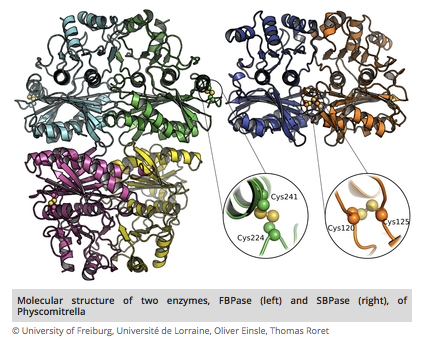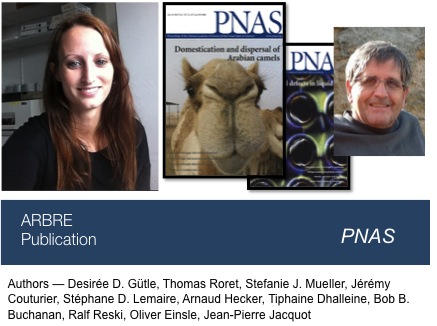Unexpected origins of photosynthesis
The conversion of light solar energy into chemical energy, a process named photosynthesis, is one of the most important biological reactions on earth. An international team of researchers from the Université de Lorraine and INRA, together with the Universities of Freiburg (Germany) UPMC (France) and the University of California at Berkeley (United States), has obtained evidence of unexpected origins of photosynthesis. Using the moss Physcomitrella patens as an experimental model, the researchers have shown that throughout their evolution, organisms belonging to two different biological domains have contributed to the elaboration of modern photosynthetic organisms able to fix CO2. This result, published in the journal Proceedings of the National Academy of Sciences of the United States of America (PNAS), marks the completion of research initiated more than forty years ago.
Oxygenic photosynthesis occurs in land plants, algae and some photosynthetic bacteria called cyanobacteria. In this process, oxygen becomes liberated from water molecules and CO2 incorporated into organic molecules as sugars. Photosynthesis is the origin of the fossil energy and organic matter available on earth today. It also plays a key role in maintaining constant oxygen levels in the atmosphere and in reducing CO2 levels, thereby minimizing the greenhouse effect.
 In plant cells, CO2 fixation involves several enzymes in the Calvin-Benson cycle. The efficiency of CO2 fixation notably conditions agronomical yields. Studies of two of these enzymes, fructose-1,6-bisphosphatase (FBPase) and sedoheptulose-bisphosphatase (SBPase), began more than forty years ago. By performing biochemical and genetic analyses in the moss Physcomitrella patens, the researchers have gained access to the molecular structures and catalytic and regulatory properties of these enzymes allowing them to trace back the evolution of the photosynthetic systems.
In plant cells, CO2 fixation involves several enzymes in the Calvin-Benson cycle. The efficiency of CO2 fixation notably conditions agronomical yields. Studies of two of these enzymes, fructose-1,6-bisphosphatase (FBPase) and sedoheptulose-bisphosphatase (SBPase), began more than forty years ago. By performing biochemical and genetic analyses in the moss Physcomitrella patens, the researchers have gained access to the molecular structures and catalytic and regulatory properties of these enzymes allowing them to trace back the evolution of the photosynthetic systems.
Surprisingly, the two moss enzymes are rather similar in structure and catalysis but they differ in their regulatory properties and phylogenetic origins. They were found to likely derive from two different biological domains. Indeed, one of the sequences is predicted to derive from alpha proteobacteria while the other one is closer to Archaea. These results support unexpected hypotheses concerning the origin of photosynthetic organisms which seem to consist of a patchwork of genes inherited from more primitive non-photosynthetic organisms which later adapted to constraints linked to the functioning of oxygenic photosynthesis. This work represents an important step toward understanding the functioning and regulation of photosynthesis and to gaining further control on plant yield.

 _______________________________
_______________________________
The results presented in this study were obtained principally from a collaboration between the Unité mixte de recherche Inra-Université de Lorraine « Interactions Arbres-Microorganismes » (IAM) and the laboratories of Plant Biotechnology in the Biology Faculty, and Biochemistry in the Chemistry and Pharmacy Faculty of Freiburg University. Additional cooperation involved laboratories at the Institut de Biologie Physico-chimique (IBPC) in Paris and the Department of Plant and Microbial Biology at the University of California, Berkeley.
This article corresponds largely to the doctoral work of Désirée Gütle in a co-tutelle between Nancy and Freiburg with help on the French side through a doctoral grant from MENRT and from LabEx ARBRE, and on the German side through funding from Excellence Initiative of the Bundes Republik Deutschland including the structures SGCBM, BIOSS, FRIAS from Freiburg. The Université franco-allemande contributed funding to both sides.



